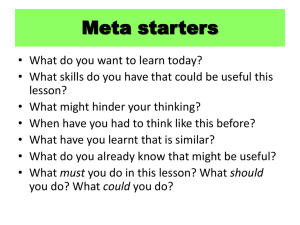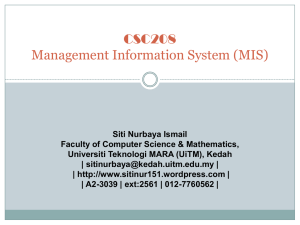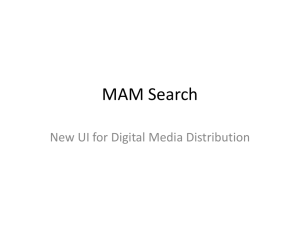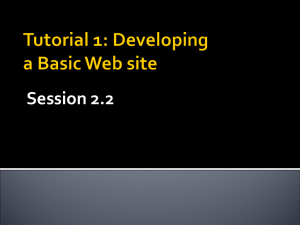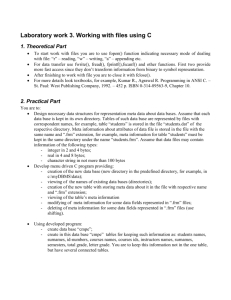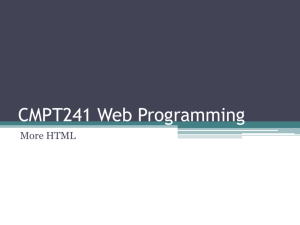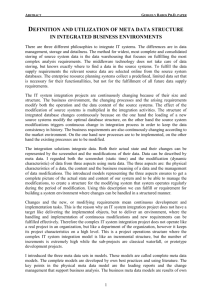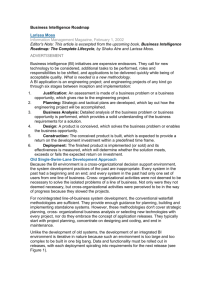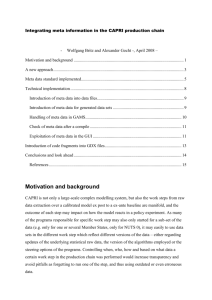DAMA-DMBOK Data Management Functional Framework Task Outline
advertisement
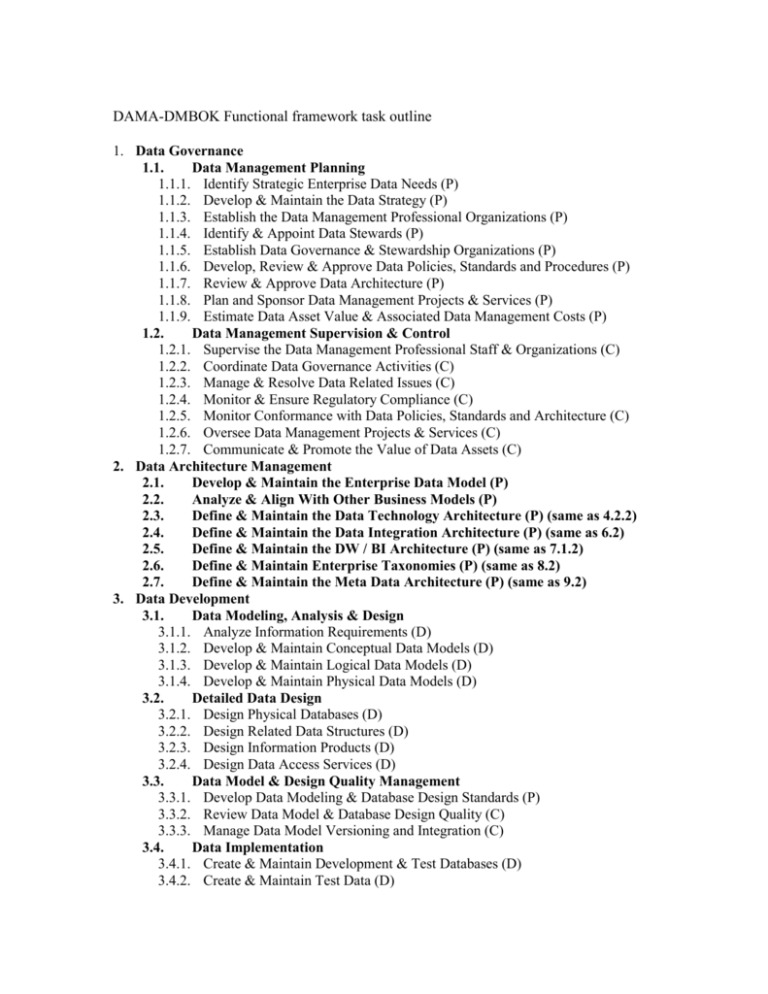
DAMA-DMBOK Functional framework task outline 1. Data Governance 1.1. Data Management Planning 1.1.1. Identify Strategic Enterprise Data Needs (P) 1.1.2. Develop & Maintain the Data Strategy (P) 1.1.3. Establish the Data Management Professional Organizations (P) 1.1.4. Identify & Appoint Data Stewards (P) 1.1.5. Establish Data Governance & Stewardship Organizations (P) 1.1.6. Develop, Review & Approve Data Policies, Standards and Procedures (P) 1.1.7. Review & Approve Data Architecture (P) 1.1.8. Plan and Sponsor Data Management Projects & Services (P) 1.1.9. Estimate Data Asset Value & Associated Data Management Costs (P) 1.2. Data Management Supervision & Control 1.2.1. Supervise the Data Management Professional Staff & Organizations (C) 1.2.2. Coordinate Data Governance Activities (C) 1.2.3. Manage & Resolve Data Related Issues (C) 1.2.4. Monitor & Ensure Regulatory Compliance (C) 1.2.5. Monitor Conformance with Data Policies, Standards and Architecture (C) 1.2.6. Oversee Data Management Projects & Services (C) 1.2.7. Communicate & Promote the Value of Data Assets (C) 2. Data Architecture Management 2.1. Develop & Maintain the Enterprise Data Model (P) 2.2. Analyze & Align With Other Business Models (P) 2.3. Define & Maintain the Data Technology Architecture (P) (same as 4.2.2) 2.4. Define & Maintain the Data Integration Architecture (P) (same as 6.2) 2.5. Define & Maintain the DW / BI Architecture (P) (same as 7.1.2) 2.6. Define & Maintain Enterprise Taxonomies (P) (same as 8.2) 2.7. Define & Maintain the Meta Data Architecture (P) (same as 9.2) 3. Data Development 3.1. Data Modeling, Analysis & Design 3.1.1. Analyze Information Requirements (D) 3.1.2. Develop & Maintain Conceptual Data Models (D) 3.1.3. Develop & Maintain Logical Data Models (D) 3.1.4. Develop & Maintain Physical Data Models (D) 3.2. Detailed Data Design 3.2.1. Design Physical Databases (D) 3.2.2. Design Related Data Structures (D) 3.2.3. Design Information Products (D) 3.2.4. Design Data Access Services (D) 3.3. Data Model & Design Quality Management 3.3.1. Develop Data Modeling & Database Design Standards (P) 3.3.2. Review Data Model & Database Design Quality (C) 3.3.3. Manage Data Model Versioning and Integration (C) 3.4. Data Implementation 3.4.1. Create & Maintain Development & Test Databases (D) 3.4.2. Create & Maintain Test Data (D) 4. 5. 6. 7. 3.4.3. Migrate & Convert Data 3.4.4. Build & Test Information Products ((D) 3.4.5. Build & Test Data Access Services (D) 3.4.6. Build & Test Data Integration Services (D) 3.4.7. Validate Information Requirements (D) 3.4.8. Prepare for Data Deployment (D) Database Operations Management 4.1. Database Support 4.1.1. Implement & Maintain Database Environments (C) 4.1.2. Implement & Control Database Changes (C) 4.1.3. Acquire Externally Sourced Data (O) 4.1.4. Plan for Data Recovery (P) 4.1.5. Backup & Recover Data (O) 4.1.6. Set Database Performance Service Levels (P) 4.1.7. Monitor & Tune Database Performance (O) 4.1.8. Plan for Data Retention (P) 4.1.9. Archive, Retrieve and Purge Data (O) 4.1.10. Manage Specialized Databases (O) 4.2. Data Technology Management 4.2.1. Understand Data Technology Requirements (P) 4.2.2. Define the Data Technology Architecture (P) (same as 2.3) 4.2.3. Evaluate Data Technology (P) 4.2.4. Install & Administer Data Technology (O) 4.2.5. Inventory & Track Data Technology Licenses (C) 4.2.6. Support Data Technology Usage & Issues (O) Data Security Management 5.1. Understand Data Privacy, Confidentiality & Security Needs (P) 5.2. Define Data Privacy & Confidentiality Policies & Standards (P) 5.3. Define Password Standards & Procedures (P) 5.4. Design & Implement Data Security Controls (D) 5.5. Manage Users, Passwords & Group Membership (C) 5.6. Manage Data Access Views (C) 5.7. Manage Data Access Permissions (C) 5.8. Monitor User Authentication & Access Behavior (C) 5.9. Classify Information Confidentiality (C) 5.10. Audit Data Security (C) Reference & Master Data Management 6.1. Understand Reference & Master Data Integration Needs (P) 6.2. Define the Data Integration Architecture (P) (same as 2.4) 6.3. Implement Reference & Master Data Management Solutions (D) 6.4. Control Code Values & Other Reference Data (C) 6.5. Integrate Master Data (O) 6.6. Replicate Reference and Master Data (O) 6.7. Maintain Dimensional Hierarchies (O) Data Warehousing & Business Intelligence Management 7.1. Data Warehousing & Business Intelligence Planning 7.1.1. Understand Business Intelligence Data Needs (P) 7.1.2. Define & Maintain the DW / BI Architecture (P) (same as 2.5) 7.2. Data Warehousing & Business Intelligence Implementation 7.2.1. Implement Data Warehouses & Data Marts (D) 7.2.2. Implement Business Intelligence Tools & User Interfaces (D) 7.2.3. Implement Enterprise Reporting (D) 7.2.4. Implement Management Dashboards & Scorecards (D) 7.2.5. Implement Analytic Applications (D) 7.3. Data Warehousing & Business Intelligence Support 7.3.1. Train Business Professionals (O) 7.3.2. Replicate & Transform Data for Business Intelligence (O) 7.3.3. Monitor & Tune Data Warehousing Processes (C) 7.3.4. Support Business Intelligence Activity (O) 7.3.5. Monitor & Tune BI Activity and Performance (C) These activities do not include actual Business Intelligence activities performed by knowledge workers, which include: Perform Ad Hoc Query & Reporting Perform Multidimensional Analysis Perform Statistical Analysis Perform Data Mining Model “What If” Scenarios Monitor and Analyze Business Performance 8. Document & Content Management 8.1. Plan for Managing Electronic & Physical Documents (P) 8.2. Define & Maintain Enterprise Taxonomies (P) (same as 2.6) 8.3. Implement & Maintain Document Storage Systems (D) 8.4. Acquire & Store Documents (O) 8.5. Index Document Information Contents (O) 8.6. Backup & Recover Documents (O) 8.7. Support Document Content Analysis (O) 8.8. Support Document Access, Circulation & Update (O) 8.9. Monitor & Tune Document Retrieval Performance (C) 8.10. Archive, Retrieve & Purge Documents (O) 8.11. Audit Document & Content Management (C) 9. Meta Data Management 9.1. Understand Meta Data Requirements (P) 9.2. Define the Meta Data Architecture (P) (same as 2.7) 9.3. Develop & Maintain Meta Data Standards (P) 9.4. Implement a Managed Meta Data Environment (D) 9.5. Create & Maintain Meta Data (O) 9.6. Integrate Meta Data (C) 9.7. Manage Meta Data Repositories (C) 9.8. Distribute & Deliver Meta Data (C) 9.9. Support Meta Data Reporting and Analysis (O) 10. Data Quality Management 10.1. Develop and Promote Data Quality Awareness (O) 10.2. Profile, Analyze & Assess Data Quality (D) 10.3. Define Data Quality Requirements & Business Rules (D) 10.4. Test & Validate Data Quality Requirements (D) 10.5. Define Data Quality Metrics & Service Levels (P) 10.6. Measure & Monitor Data Quality (C) 10.7. Manage Data Quality Issues (C) 10.8. 10.9. 10.10. 10.11. Correct Data Quality Defects (O) Design & Implement Operational DQM Procedures (D) Monitor Operational DQM Procedures & Performance (C) Audit Data Quality (C) Each activity is categorized as belonging to one of four Activity Groups: Planning Activities (P) - Activities that set the strategic and tactical course for other data management activities. Planning activities may be performed on a recurring basis. Control Activities (C) - Supervisory activities performed on an on-going basis. Development Activities (D) - Activities undertaken within projects and recognized as part of the systems development lifecycle (SDLC), creating data deliverables through analysis, design, building, testing and deployment. Operational Activities (O) - Service and support activities performed on an on-going basis.
